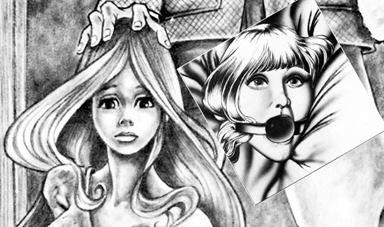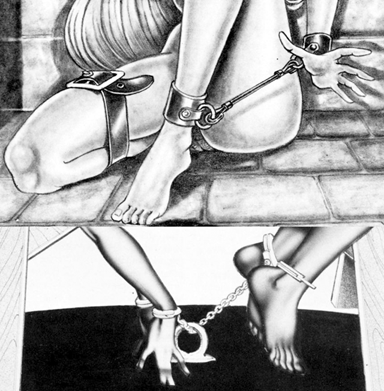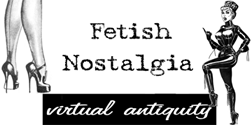the question of Bishop and Ashely

A gentleman in Germany, interested in erotic illustration, wrote to us about the work of Robert Bishop and its presentation in Fetish Nostalgia ebooks. We exchanged views via email.
He recently suggested that our correspondence be made public on the website, which seems like a good idea. What follows are our messages, edited for reader convenience and with modifications.
his note to 30sg.com:
. . . . I hope that you can publish more from the Fellowes series.
I read somewhere that Ashely was a pseudonym of Robert Bishop. The expressiveness and the technical virtuosity of the pictures surely are in accordance with Bishop's artistic mastery. The wealth of intricate bondage positions, the anatomical correctness and the liveliness of the facial expressions, in particular the eyes, are the hallmark of Bishop's art. Do you have more information about the author?
our reply
I do not believe that Ashley is one of Mr. Bishop's pseudonyms. I don't believe he worked on the Fellowes booklets.
Eyes may be an important element of Mr. Bishop's facial graphics. Ashely eyes form up as trapezoids. Bishop eyes are elliptical.
Ashley's eyes have four corners. Bishop's consist of two curves that intersect twice.

Bishop's eyes show more whites. Ashely's eyelids cover more of the irises.
Ashely's heroine is taller than Bishop's feminine ideal, and slimmer.
The most clear points of departure between the two are hands and feet. These objects occupy much study and practice in art school and there are many books on the subject of showing posed digits in perspective. You could say that delineation of fingers express an illustrator's signature.
As Ashely's matrix is taller and more slender, the same is true of his(her) feet and hands. They have different structure and proportion. Ashley's feet consistently show curves at the edges of soles. Bishops feet acknowledge the existence of arches, but his soles are usually flat. Also, the tops (insteps) of Ashley's feet often show subtle curves, while Bishop's are mostly straight.

In a 1986 essay he titles “A Little Ruminating” in Bishop on Bondage, Number 5, the master gripes about the task:
. . . . As my skills have become more honed, I find myself expecting steadily more and more of myself. In a lot of cases, it isn't even the esoteric stuff either. Sit down and try drawing a hand sometime. And feet! Madre! I've had lots of practice, but it's still a grizzly exercise. I think I hate drawing feet more than hands, if it ever came down to making a choice. Nothing against feet, shoe lovers! Don't get me wrong here, I like the look of a tall black leather boot as much as the next man; I just hate drawing the goddamned things.
If Fanni's and Emily's fingers were drawn by the same person they would show similar proportions and reflect similar technique. Bishop was so good at his craft that his fingers suggest strength, even when bound. Ashley's hands are graceful, feminine and useless. Bishop's fingernails are more clearly defined and more recently manicured.
I'd generalize that Bishop's inks and airbrush paint have a more industrial/technical style. He worked out a set of rules to accomplish his anatomical objectives. In addition to airbrush, some of his shading is accomplished with adhesive textures that are pressed on to drawings.
Ashely's pencil seems forever on a quest to discover new curves and curls. The artist's pencil shadings on flesh and fabric are similar to Stanton's.
Both Bishop and Ashely use dark outlines to show anatomical shapes. This is a popular technique for many comic artists (e.g., Mickey Mouse). Ashley's lines observe a consistent thickness (as do Bilbrew's).
Bishop's perimeters vary in thickness. Thickness variations suggest contour on anatomy that contains no shading.
Mr. Bishop also observes content differences between himself and Mr. Campbell (often Ashley's writer) in “A Little Ruminating”:
Frank Campbell and I have frequently gotten into howling matches when the wonderful world of restraints was a subject of contention. Frank likes it almost spartan in simplicity—handcuffs only, thank you. And no gags! Balderdash, I say. Ropes or straps. Tight. Lots of them! And huge gags! Frank likes them standing languid against the post, with only a single wrist held over her head by the cuffs. I like them roped into a tiny ball of a hogtie, elbows glued together, mouth around some great succulent ball with a leash going from her collar to the pole, if you really have to have the damned thing, and screw handcuffs.
Bilbrew used several aliases for his work and his styles vary from ink to watercolor to pencil to paint. But we can tell it's Bilbrew, from what we might call the palette of Bilbrew's graphic personae.
Stanton's pencil work of 1962 differs from his Stantoon's penciling of 1982. But we still recognize those figures and faces as Stanton's.
Based on the record, Bishop was a storyteller and writer. Ashely only illuminated Campbell's texts (although we could speculate that Campbell is also a pseudonym for Bishop).
Campbell's prose is Anglophile, if not actually British. Bishop's texts brim with contemporary Americanisms, informed by TV and radio cliches. Could one artist write both?
It's fun and convenient for us to connect artists like Ashely and Bishop. They managed the same themes and were popularized by the same publisher. Visually, I don't see a connection between Bishop and Ashely.
his reply to our comments (fragment)
Here are some places where the Bishop-Ashely-Identity is repeated:
https://bdsm-artzone.de/art-infos/art001/info-bishop.htm
(Er arbeitete ebenfalls unter dem Pseudonym "Ashely")
https://www.bdsm-artzone.de/art-infos/art001/info-ashely.htm
(Pseudonym von Robert Bishop)
https://www.e3m-shop.com/advanced_search_result.php?keywords=bishop&x=0&y=0
The Wikipedia article about Robert Bishop refers to this this website in footnotes/references 2 and 6.
